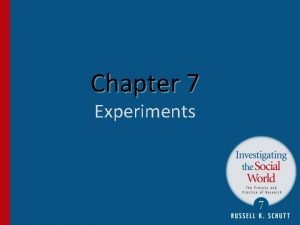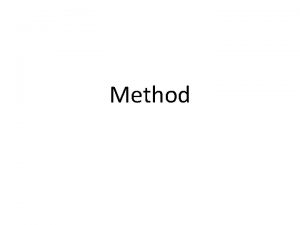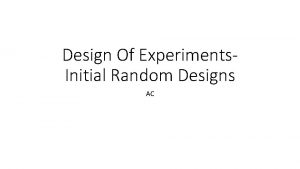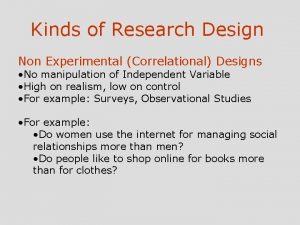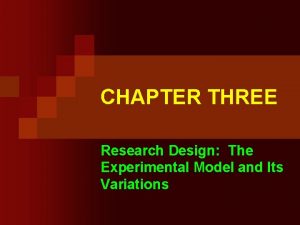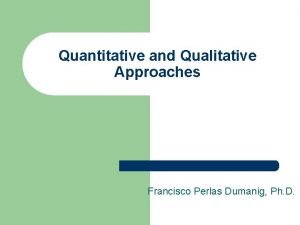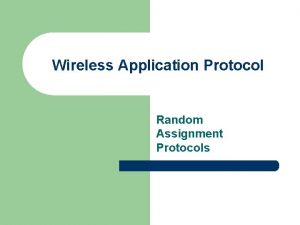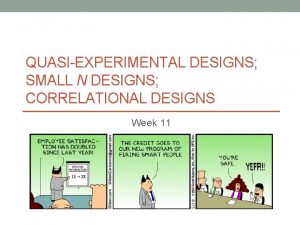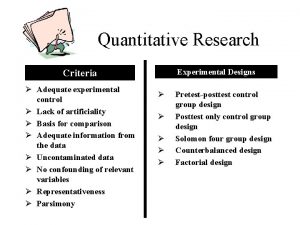Lecture 13 Research Design Designs Experimental Random assignment
























- Slides: 24

Lecture 13: Research Design

Designs • Experimental – Random assignment of units – Manipulation • Quasi-experimental – Non-random assignment of units – Manipulation • Observational – Cross-sectional – Retrospective – Prospective



Remember to Always Think About What Is The Independent and What is the Dependent Variable!


Strategies for Bounding Groups • Groups mostly have fuzzy boundaries • Even well defined organizations or social units have fuzzy boundaries (e. g. , corporations)

Sampling and Bounding

A Clear Group: Nominalist Criteria (etic)

Nominalist • There are clear members and non-members of the network • It is not that there are not network relations outside the group it is just that the hypothesized influences of network factors on behavior or behavior on network factors is exclusive to the group context (e. g. , network structures effect on group performance) • Any threat to validity concerns unmeasured network influences on the study

Realist Strategies (emic) • Networks determined this way can have extremely fuzzy boundaries • Boundaries are derived from the potential members themselves or by the nominations of group members of other members • Possible difficulty in knowing where to draw the final boundary

Empirically Derived Group: Realists (emic)

Snowball Sample and Boundaries • Snowball sample of actors associated with king mackerel fishing in the Southeast US • Random selection of initial set of actors (from license lists) • Each actor would then be asked to name k other people they talked to about king mackerel fishing (in this case k = 3) • This was then repeated for multiple waves until there was sufficient network closure (i. e. , no new names being mentioned)

Yielded a Network of 238 Actors

Missing Data and Other Errors • Missing data in social network research is much more problematic than in other types of social research (e. g. , nonresponse) • Must do everything possible to avoid missing data and errors of other kinds • Talked about some of these in data collection

Impact of Errors

Types of Errors • • Omission Errors Commission Errors Edge/node attribution errors Data collection and retrospective errors Data fusion/aggregation errors Errors in secondary sources and data mining Formatting errors

Omission Errors Commission Errors • Missing edges and nodes can have huge impacts on errors in network variables, particularly for some centrality measures. • Like omission errors, the erroneous inclusion of nodes and edges can affect the ultimate determination of node-level measures and the identification of key nodes

Edge/node attribution errors • These result from assigning a behavior or attributing something to either an edge or node incorrectly. Misassignment of a behavior to a node can yield attributed linkages in a network that in reality do not exist. Attribution error is a common problem in the interpretation of twomode data that has been converted to one-mode.

Data collection and retrospective errors • Care should likewise be taken when using network data collected from individuals where the network elicitation question deals with reports of behavior, particularly having to do with social interactions of a temporally discrete nature • BKS

Data fusion/aggregation errors • Decisions often have to be made on aggregating data on different temporal, relational and spatial scales. Such aggregations, if done improperly, can create errors at a variety of levels.

Errors in secondary sources and data mining • Various forms of secondary source data may have inherent biases which should be considered in any analysis. This type of data can be easier to collect than primary types of data (e. g. , data scraped from the Web), but it can be fraught with errors at a variety of levels.

Formatting Errors • In data mining or web scraping there are errors that can be due to differences in document or website formatting. These errors can lead to the over- or under-representation of terms, actors, attributes, etc. , in the data retrieval process.

Next: Lecture 14 Theory in Networks http: //www. chineseenglish. com/wp-content/uploads/2009/11/birds-of-a-feather-flock-together. gif
 Random assignment vs random sampling
Random assignment vs random sampling Random assignment vs random selection
Random assignment vs random selection Quasi-experimental research designs
Quasi-experimental research designs Quasi-experimental research designs
Quasi-experimental research designs Disadvantages of experimental research
Disadvantages of experimental research Non experimental design vs experimental
Non experimental design vs experimental Key principles of experimental design
Key principles of experimental design Matched pairs design
Matched pairs design Diagnostic research design meaning
Diagnostic research design meaning Basic principles of experimental design
Basic principles of experimental design Research paradigm example
Research paradigm example Research instrument in experimental research
Research instrument in experimental research Random designs
Random designs Experimental vs non experimental
Experimental vs non experimental Cross-sectional correlational design
Cross-sectional correlational design Experimental vs non experimental
Experimental vs non experimental Characteristics of experimental research design
Characteristics of experimental research design Example of experiment research
Example of experiment research Quasi experiment advantages and disadvantages
Quasi experiment advantages and disadvantages Non experimental correlational design
Non experimental correlational design Quasi experimental design notation
Quasi experimental design notation Quasi experimental design
Quasi experimental design Classic experimental design
Classic experimental design Experimental research design types
Experimental research design types Analyzing and interpreting data in research
Analyzing and interpreting data in research



